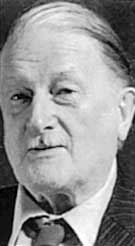Ronald Syme
This article has multiple issues. Please help improve it or discuss these issues on the talk page. (Learn how and when to remove these template messages)
|
OM FBA | |
|---|---|
 | |
| Born | 11 March 1903 Eltham, New Zealand |
| Died | 4 September 1989 (aged 86) |
| Nationality | New Zealander, British |
| Academic background | |
| Education | New Plymouth Boys' High School |
| Alma mater | |
| Academic work | |
| Discipline | |
| Institutions | |
| Doctoral students | Barbara Levick Miriam T. Griffin Fergus Millar |
| Notable works | The Roman Revolution (1939) |
Sir Ronald Syme,
Life
Syme was born to David and Florence Syme in
His first scholarly work was published by the
Sir Ronald's work at
After being elected a Fellow of the British Academy in 1944, Syme was appointed Camden Professor of Ancient History at Brasenose College, Oxford, in 1949, a position which he held until his retirement in 1970. Syme was also appointed fellow of Wolfson College, Oxford, from 1970 until the late 1980s, where an annual lecture was established in his memory.
Syme was knighted in 1959. He was elected to the
Major works
The work for which Syme is chiefly remembered,
Syme's next great work was his definitive two-volume biography of Tacitus (1958), his favourite among the ancient historians. The work's forty-five chapters and ninety-five appendices make up the most complete study of Tacitus yet produced, backed by an exhaustive treatment of the historical and political background—the Empire's first century—of his life. Syme blended biographical investigation, historical narrative and interpretation, and literary analysis to produce what may be the single most thorough study of a major historian ever published.[citation needed]
In 1958, Oxford University Press published Colonial Élites. Rome, Spain and the Americas, which presents the three lectures that Syme offered at McMaster University in January 1958 as part of the Whidden Lectures. Syme compares the three empires that have endured for the longest periods of time in Western History: Rome, Spain, and Britain. Syme considers that the duration of an Empire links directly to the character of the men who are in charge of the imperial administration, in particular that of the colonies. In his own words, the "strength and vitality of an empire is frequently due to the new aristocracy from the periphery". This book is currently out of print.[6]
Syme's biography of
His History in Ovid (1978) places the great Roman poet Ovid firmly in his social context.
Syme's The Augustan Aristocracy (1986) traces the prominent families under Augustus as a sequel to The Roman Revolution. Syme examined how and why Augustus promoted bankrupt patrician families and new politicians simultaneously to forge a coalition in government that would back his agenda for a new Rome.
A posthumous work (edited for publication by A. Birley), Anatolica (1995), is devoted to
Syme's doctoral students at the University of Oxford included Barbara Levick (whose thesis in the mid-1950s dealt with Roman colonies in south Asia Minor), and Miriam T. Griffin (1968), whose thesis was entitled Seneca: the statesman and the writer.
Legacy
- Victoria University of Wellington's Classics Department holds a lecture in Syme's honour every two years.
References
- ^ "Ronald Syme, 86, Classics Scholar And Historian at Oxford, Is Dead", The New York Times, 7 September 1989
- ^ JSTOR 987156. Retrieved 9 May 2022.
- ^ "Rhine and Danube Legions under Domitian", Journal of Roman Studies 18 (1928) 41–55; see Anthony Birley, "Editor's Introduction", in The Provincial at Rome (Presses Université Laval, 2000), p. xi online and pp. xi–xx on Syme's publications and scholarly career.
- ^ "APS Member History". search.amphilsoc.org. Retrieved 6 December 2022.
- ^ "Ronald Syme". American Academy of Arts & Sciences. Retrieved 6 December 2022.
- ^ "Colonial Élites. Rome, Spain and the Americas – Sir Ronald Syme". Francisco Vázquez. Archived from the original on 30 June 2012. Retrieved 15 May 2010.
- S2CID 161240896.
- JSTOR 1086288.
- ^ Syme, Sir Ronald (1971). Emperors and Biography: Studies in the Historia Augusta. Clarendon Press.
- ^ Emperors and Biography (Oxford, 1971), p. 263.
- JSTOR 4347597– via JSTOR.
- JSTOR 1859532– via Oxford Academic.
- ^ Syme, Sir Ronald (1971). Emperors and Biography: Studies in the Historia Augusta. Clarendon Press. p. 8.
- ^ Syme, Sir Ronald (1971). Emperors and Biography: Studies in the Historia Augusta. Clarendon Press. p. 14.
Further reading
- ISBN 978-1-988533-17-9.
- Obituaries of Syme appear in the Proceedings of the American Philosophical Society (vol. 135, no. 1, 119–122) and in The Journal of Roman Studies (vol. 80, xi–xiv)
- Mitchell, S. (1989). "Obituary: Sir Ronald Syme". JSTOR 3642808.
